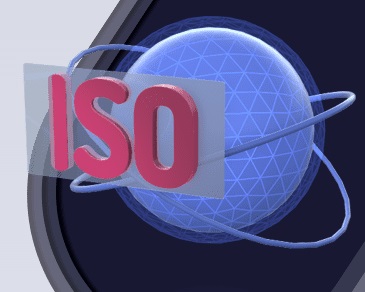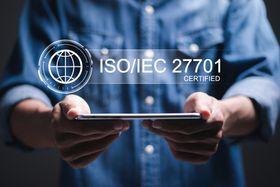What Is ISO 27001? Understanding the Importance & Key Principles
Learn what ISO 27001 is and why it’s essential for managing information security.
Published April 5, 2025.

The modern rise in sophisticated cybersecurity threats, data breaches, and evolving regulatory demands has created an urgent need for robust security measures. Effective cybersecurity requires a comprehensive risk approach that includes risk assessment, strong security controls, continuous monitoring, and ongoing improvements to stay ahead of threats. This stance will reduce the likelihood of security accidents and strengthen credibility.
ISO 27001 is an important component of this comprehensive cybersecurity effort, offering a structured framework to manage security. It emphasizes the creation of an adaptable Information Security Management System (ISMS), helping organizations systematically identify and address vulnerabilities while aligning controls with business and regulatory needs.
» Ready to become ISO 27001 compliant? Find out how GRSee can help
Understanding ISO 27001
ISO 27001 is a globally recognized standard that provides a structured framework for managing information security through the implementation of an Information Security Management System (ISMS).
It centers on three principles:
- Confidentiality: Ensures sensitive data is accessible only to authorized individuals.
- Integrity: Guarantees that information remains accurate and unaltered.
- Availability: Ensures data is accessible when needed.
Key Components of ISO 27001 Explained
- Information Security Management System (ISMS): A central component of ISO 27001 that defines the processes, policies, and controls required to manage and protect information systematically.
- Risk-based approach: Focuses on identifying potential security threats, assessing vulnerabilities, and implementing controls to minimize risks.
- Leadership commitment: Highlights the need for top management to support the ISMS, allocate resources, and drive a culture of security throughout the organization.
- Documentation and policies: Ensures all security-related activities are thoroughly documented, covering policies, procedures, and roles for accountability and clarity.
» Learn why you need to be ISO 27001 certified
How ISO 27001 Differs from Other Security Standards
| Standard | Focus | Certification | Common Usage |
|---|---|---|---|
| ISO 27001 | Comprehensive information security management through ISMS, covering people, processes, and technology. | Formal certification available. | Widely adopted globally, especially in Europe and industries with regulatory needs. |
| SOC 2 | Specific services or environments; audit report based on Trust Service Criteria. | No certification, only an audit report. | Widely used in North America for service providers managing client data. |
| NIST | Flexible framework for improving cybersecurity practices; offers guidelines for implementation. | No formal certification process. | Commonly used by government agencies and regulated industries in North America. |
| PCI DSS | Strict controls for securing credit card data; narrowly focused on payment environments. | Formal certification available. | Used by businesses handling credit card information. |
» Discover: NIST vs. ISO 27001—Find the right framework for your business
The Role and Relevance of Annex A Controls
Annex A is a foundational element of ISO 27001, outlining 93 controls designed to address a broad spectrum of information security risks.
| Category | Focus | Examples of Controls |
|---|---|---|
| Organizational | Policies, governance, and processes to manage security at the organizational level. | Risk management, supplier relationships, incident response planning, and roles and responsibilities. |
| People | Mitigating human-related risks through training, awareness, and access management. | Security awareness programs, access control policies, and addressing insider threats. |
| Physical | Protecting physical access to critical infrastructure and sensitive information. | Secure facility design, environmental protection, and physical access controls. |
| Technological | Implementing technical measures to secure information systems against cyber threats. | Encryption, network security, malware protection, and system configuration. |
1. Obtain Leadership Commitment
Successful implementation begins with securing top management support to allocate resources, define objectives, and promote a culture of security throughout the organization. Leadership involvement is critical for ensuring that the ISMS remains a priority and aligns with the organization’s strategic goals.
2. Define the Scope of the ISMS
Clearly outline the boundaries of your ISMS, identifying the assets, departments, and processes it will cover, ensuring alignment with business goals and regulatory requirements. A well-defined scope helps focus efforts and ensures that the ISMS addresses all relevant areas without wasting resources.
3. Conduct a Risk Assessment
Identify potential risks, evaluate their likelihood and impact, and prioritize controls to mitigate these risks effectively. A thorough risk assessment provides the foundation for an ISMS tailored to address your organization’s most critical threats.
4. Develop Policies and Controls
Establish and document security policies and implement controls based on the findings from the risk assessment process, ensuring they are tailored to the organization’s unique needs. Effective policies provide clear guidance, while well-designed controls directly reduce risks and enhance security.
5. Train and Raise Awareness
Provide employees with the necessary training and awareness to understand their roles in maintaining the ISMS, fostering a security-first mindset across the organization. Engaged and knowledgeable employees are essential for embedding security practices into daily operations.
The process culminates in an external audit conducted by a certification body. Regular internal audits, management reviews, and continuous improvements are required to maintain certification, ensuring the ISMS evolves with emerging risks and business changes.
» Need more guidance? Check out this guide on how to become ISO 27001 compliant
Addressing Common Implementation Challenges
- Extensive documentation requirements: ISO 27001 demands comprehensive documentation for processes, policies, and controls, which can be streamlined using templates, software tools, or expert consultants.
- Limited internal expertise: Many organizations lack in-house knowledge or experience with ISO 27001, so investing in training or partnering with a consulting firm can help bridge this gap.
- Resistance to change: Shifting organizational culture often meets resistance, but engaging leadership and conducting regular awareness sessions can improve acceptance and support.
- Maintaining compliance over time: Sustaining compliance requires ongoing effort, including audits, updates to controls, and adapting to risks, which can be managed by establishing a continuous improvement cycle with clear responsibilities.
» Find out how to use ISO 27001 to reach CCPA compliance
Essential ISO 27001 Documentation and Policies
Core documents
- Information security policy: Defines the organization’s commitment to protecting sensitive data and sets the tone for the ISMS.
- Statement of applicability: Lists all controls from Annex A, highlighting which are implemented and explaining any exclusions.
Supporting policies and procedures
- Access control policy: Outlines how access to information is managed and restricted based on roles and responsibilities.
- Incident management policy: Describes how security incidents are identified, reported, and resolved to minimize risk.
- Risk assessment methodology: Provides a structured approach to identifying, evaluating, and mitigating security risks.
Operational records
- Risk assessment logs: Evidence of risk evaluation and mitigation efforts.
- Audit reports: Records of internal audits to monitor ISMS effectiveness.
- Training records: Documentation of employee training and awareness programs.
Benefits of ISO 27001 for Security and Business Growth
1. Enhanced Security Posture
ISO 27001 helps organizations build a proactive approach to managing risks by identifying vulnerabilities, implementing robust controls, and continuously improving their security measures. This reduces the likelihood of data breaches and ensures sensitive information remains protected from both internal and external threats.
2. Regulatory Compliance and Client Trust
Adopting ISO 27001 demonstrates a commitment to meeting regulatory and legal requirements, making it easier to comply with data protection laws such as GDPR. The certification provides clear signals to clients and stakeholders that security is a top priority, fostering confidence and strengthening long-term relationships.
» Learn how to get started with GDPR compliance
3. Competitive Advantage
ISO 27001 certification is increasingly seen as a business differentiator, especially in industries where information security is a critical requirement. Companies with this certification are often preferred by clients and partners, giving them an edge in competitive markets.
4. Operational Efficiency
The structured framework of ISO 27001 streamlines security processes, reducing redundancies and improving overall efficiency. By aligning security practices with business goals, organizations can integrate security into their daily operations, making it a seamless part of their workflow.
With ISO 27001, organizations not only protect their assets but also position themselves as reliable, forward-thinking partners in an increasingly data-driven world. This dual focus on security and growth makes it an invaluable tool for businesses aiming to succeed in today’s competitive landscape.
» Did you know? The cloud might not be safe anymore
Continuous Improvement and Long-Term Compliance
Achieving initial certification is just the beginning; maintaining compliance involves a series of ongoing practices:
- Regular internal audits: These help identify non-conformities and areas for improvement, ensuring the ISMS is consistently aligned with the organization’s goals.
- Management reviews: Leadership regularly evaluates the ISMS to confirm its effectiveness and alignment with business objectives and regulatory requirements.
- Updates to security controls: Organizations must adapt controls to address emerging threats, new technologies, and changes in the regulatory landscape.
- Proactive risk management: Staying ahead of vulnerabilities requires a vigilant approach to identifying and mitigating risks as they arise.
» Check out these cyber tips for your startup plan
How SMEs Can Benefit From ISO 27001 Implementation With GRSee
Small and medium-sized enterprises (SMEs) often find ISO 27001 implementation more straightforward due to their smaller structures and processes. Starting early helps build a security foundation that scales with growth. Compliance automation platforms can streamline tasks like evidence gathering and control management, especially when paired with a solid strategy.
At GRSee, we simplify ISO 27001 certification with tailored solutions, expert guidance, and practical tools. From gap analyses to audit preparation, we help SMEs achieve certification efficiently while establishing a lasting security framework.
» Ready to begin? Contact us to start your ISO 27001 compliance process







